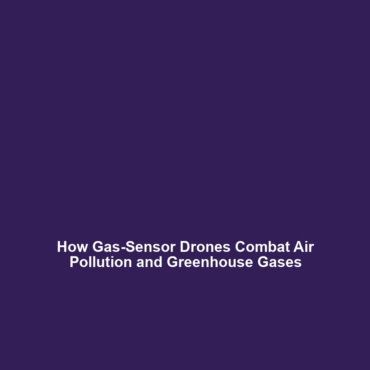How Drones Equipped with Gas Sensors Detect Air Pollutants and Greenhouse Gases
Introduction
Drones equipped with gas sensors are revolutionizing the field of environmental monitoring by accurately detecting air pollutants and greenhouse gases. This innovative technology holds significant implications for public health, climate change, and regulatory compliance. As concerns about air quality escalate globally, understanding the capability of these drones in science becomes increasingly vital. This article delves into how drones equipped with gas sensors serve as effective tools in identifying and measuring harmful emissions, thereby contributing to sound environmental practices and policies.
Key Concepts
Understanding Gas Sensors
Gas sensors are devices that detect the presence of various gases in the atmosphere, providing quantitative data on air quality. Integrating these sensors into drones allows for aerial monitoring, offering a birds-eye view of pollution hotspots.
Drones in Science
Positioned at the intersection of technology and environmental science, drones in science facilitate rapid data collection over large areas. Their ability to navigate difficult terrains makes them ideal for monitoring remote or hazardous locations.
Applications and Real-World Uses
How drones equipped with gas sensors detect air pollutants and greenhouse gases extends into various significant applications:
- Urban Air Quality Monitoring: Cities can deploy drones to map air pollution levels in real-time, allowing for timely responses to hazardous conditions.
- Industrial Emissions Surveillance: Companies can use drones to monitor emissions from facilities, ensuring compliance with environmental regulations.
- Agricultural Assessments: Drones help in identifying methane emissions from livestock and other agricultural practices, promoting sustainable farming methods.
Current Challenges
Despite their potential, there are several challenges of drones equipped with gas sensors:
- Technical Limitations: Sensor sensitivity and calibration issues can impact measurement accuracy.
- Regulatory Barriers: Airspace regulations may limit the operation of drones in certain areas.
- Data Management: Integrating and interpreting the large amounts of data generated requires sophisticated analysis tools and expertise.
Future Research and Innovations
The future of how drones equipped with gas sensors detect air pollutants is promising, with several innovations on the horizon:
- Advanced Sensor Technologies: Development of smaller, more sensitive sensors that can detect lower concentrations of gases.
- AI Integration: Incorporating artificial intelligence for smarter data analysis and predictive modeling to anticipate pollution trends.
- Improved Drone Autonomy: Enhancements in drone navigation and autonomy that facilitate automated surveying of pollution over time.
Conclusion
In summary, drones equipped with gas sensors significantly contribute to understanding and addressing air pollutants and greenhouse gases, marking an essential advancement in the realm of drones in science. As technology advances, the potential for more precise, efficient, and widespread use of drones in environmental monitoring will grow. For further exploration of how these technologies are shaping our world, visit our related articles for more insights and information.
